Cadet Nurse Corps
United States (U.S.) Cadet Nurse Corps (CNC) was authorized by the U.S. Congress and signed into law as a nondiscriminatory program in July 1943. Its purpose was to help alleviate the nursing shortage that existed during World War II. The United States Public Health Service (USPHS) was named the supervisory agency; it was answerable to the surgeon general of the United States, Thomas Parran, Jr. The USPHS established a division to administer the CNC program and Parran appointed Lucile Petry, a registered nurse (RN), as its director.
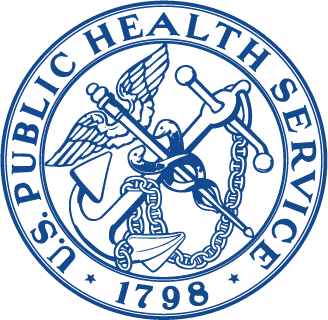 Seal of the U.S. Publc Health Service (USPHS) | |
| Agency overview | |
|---|---|
| Formed | 1 July 1943 |
| Dissolved | 31 December 1948 |
| Headquarters | United States |
| Agency executive |
|
| Parent agency | United States Public Health Service (USPHS) |
The program was open to all women between the ages of 17 and 35 who were in good health and had graduated from an accredited high school. The recruiting target was the high-school graduate but college women were also recruited. Few media sources lacked advertising for the CNC. All state nursing schools in the U.S. were eligible to participate in the program; they were, however, required to be accredited by the accrediting agency in their state and be connected with a hospital that had been approved by the American College of Surgeons. The participating schools of nursing were required to compress the traditional nursing program of 36 months into 30 months and were obligated to provide the students with the clinical experiences of medicine, surgery, pediatrics, and obstetrics.
The cadets came from locations across the nation and from all backgrounds. The CNC was the largest of the federal nurse-training programs; it allowed young women to serve their country in uniform and without discrimination. Of the 1,300 schools of nursing in the country, 1,125 participated in the program. The CNC operated from 1943 until 1948; during this period 179,294 student nurses enrolled in the program and 124,065 of them graduated from participating nursing schools. The American Hospital Association credited the cadet student nurses with helping to prevent the collapse of civilian nursing in the U.S. during the war.
Background
The U.S. experienced a shortage of nurses long before its entry into World War II; this shortage worsened with the prewar buildup of the military and industrial upturn that followed.[1] Professional nursing groups were unprepared to deal with the problem. On 10 July 1940, however, the situation changed when Isabel M. Stewart, professor of nursing at Columbia University and a member of the National League for Nursing wrote to its president: "I believe we should have a committee or board that is representative of the nursing profession as a whole and it should be at work now ...".[2] Within three weeks, on 29 July 1940, representatives of the national nursing community gathered in New York City under the umbrella of the American Nurses Association, where they formed the Nursing Council on National Defense.[3] In its first order of business, the council concentrated on surveying nursing resources and securing federal funding to expand nursing educational opportunities.[4]
The survey results indicated 100,000 nurses were eligible for the military service and that most nursing schools were ill-equipped to enlarge their instructional or housing facilities.[Note 1][7] The council submitted its federal aid request for fiscal year 1 July 1941 to 30 June 1942 to the U.S. commissioner of education, who approved it and moved it on to the Bureau of the Budget.[8] The Congress enacted and funded the Nurse Training Program, which assisted in the education of 12,000 students at 309 nursing schools. Through the program, 3,800 inactive nurses received refresher courses and 4,800 graduate nurses received postgraduate training. By the end of the fiscal year, 47,500 students were enrolled in nursing schools but this did not meet the country's demands. Nurses could not be trained quickly enough to keep pace with the civilian and military populations.[9]
During 1942, the Office of War Information tried to mobilize interest in the nursing profession using prime-time radio advertisements, saturating broadcasts with interviews, dramatic sketches, and spot announcements urging young women to join the nursing profession. While these efforts were helpful, they did not meet expectations.[10] The supporters of the nurse training programs recommended doubling federal aid for basic nursing education in the fiscal year ending 30 June 1943. Representative Frances P. Bolton of Ohio, a longtime advocate of nursing, supported the proposed increase in federal aid, advising the Congress that further aid requests for the nurse training programs were likely.[11]
Creation of the program
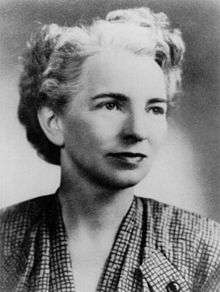
Bolton took the initiative and introduced H.R. 2326, a bill to create and fund a training program for nurses, on 29 March 1943. The Senate added an amendment that prohibited discrimination based upon race, color, or creed. At the bill's legislative hearings, hospital groups explained how distressed nursing care in civilian hospitals had become. Support for the bill also came in the form of letters and telegrams. The bill passed both houses of the Congress by unanimous vote on 15 June 1943 and became Public Law 74 on 1 July 1943; with the title of Nurse Training Act of 1943 but commonly referred to as the Bolton act. It provided for the training of nurses for the armed forces, government and civilian hospitals, health agencies, and war industries through grants to the institutions providing the training.[12][Note 2] It also contained a provision requiring that those trained under the act would comprise a uniformed body,[14] although they were not a part of any U.S. military service.[15]
The Division of Nurse Education was established in the USPHS to supervise the program; it was answerable to the surgeon general of the United States, Thomas Parran Jr. He appointed Lucile Petry, a registered nurse (RN), as the director.[16] The federal security administrator was required to appoint an advisory committee to assist in guiding the nurse-training programs. The committee consisted of people in the nursing and related fields, who were drawn from various parts of the country.[Note 3][18] On 25 June 1943, the committee met for the first time with government officials to establish the rules and regulations to carry out the act. As required, they were approved by the surgeon general and published in the Federal Register[19]
The surgeon general then sent a telegram outlining the program to 1,300 nursing schools in the United States and Puerto Rico. This was followed up with applications and instructions sent by mail. Hawaii's two nursing schools were not eligible for the program because they were in a war zone and Alaska had no nursing schools at the time.[20] The regulations required interested nursing schools to:
- be state accredited;
- be connected with a hospital approved by the American College of Surgeons or a hospital of equal standards;
- maintain adequate instructional facilities and personnel;
- provide adequate clinical experience in four basic services—medicine, surgery, pediatrics, and obstetrics;
- provide maintenance and a stipend of $30.00 for all senior cadet nurses, or arrange for their requested transfer to federal or other hospitals;
- provide satisfactory living facilities and an adequate health service for students;
- provide for an accelerated program; and
- restrict its hours of practice.[21]
The standards of the National League of Nursing Education were adopted to evaluate the participating schools.[22] After issuing these regulations, the surgeon general said; "The schools of nursing are free to select students, to plan curricula, and to formulate policies consistent with the Act and the traditions of the institution concerned. This is a partnership job between the USPHS, the institutions, and the students ... ".[16]}} The CNC was open to all women between the ages of 17 and 35 who were in good health and had graduated from an accredited high school. Marriage was permissible subject to individual nursing school guidelines. Successful applicants were eligible for a government subsidy that paid for tuition, books, uniforms, and a stipend. In exchange, student cadets were required to pledge[Note 4] to actively serve in essential civilian or federal government services for the duration of World War II.[25] All state-accredited schools of nursing were eligible to participate in the program; each school, however, was required to apply individually. Of the 1,300 nursing schools in the country, 1,125 participated. For this program, the traditional 36-month nurse training was accelerated to 30 months. Senior nursing students were required to work for a six-month period in a hospital or in another health agency. In return, the federal government would pay the schools for the related tuition and fees of the students.[26]
The committee was also responsible for naming the new program. The Victory Nurse Corps and the Student War Nursing Reserve were considered but both were rejected in favor of the United States Cadet Nurse Corps (CNC).[27]
Housing
In its 1940 survey, the Nursing Council on National Defense reported that most of the nursing schools in the U.S. were ill-equipped to enlarge their housing and classroom facilities.[4] In the following two fiscal years, federal aid was provided to nursing schools for nurse training but it did not provide any aid for housing facilities.[5] Even with the passage of the Nurse Training Act of 1943, the problem remained. Some schools were able to rent or purchase additional buildings; those that could not requested the federal government for assistance. Without funds for physical facilities, the USPHS arranged with the Federal Works Agency to allow nursing schools to share in some of the construction funds provided under the National Defense Act of 1940. The two federal agencies agreed the need for housing and other facilities in nursing schools would be based on school participation in the CNC program. The Federal Works Agency would decide where, how, and to whom the aid would be granted.[28]
Under the agreement, the schools of nursing that could not otherwise accommodate classes would receive a share of the federal aid for housing. It would include aid for living quarters, library space, classrooms, and demonstration rooms. The amount allocated for construction projects was $25,657.785. The Federal Works Agency projects started in September 1943 and ended in November 1944; during this period, about 400 applications consisting of 160 for training facilities, 172 for construction, and 68 for the purchase, lease, or renovation of exiting buildings, were cleared. Nursing schools in all but nine states were helped by the federal aid; the arrangement called for the nursing schools to share in the cost of the projects. Of the $25,657.785 spent on the nursing school projects, federal aid paid 17,397.002 (about 67.8 percent) and the nursing schools paid $8,260.783. (about 32.2 percent). In addition an unknown number of applications for building material, which were paid for by the nursing schools' own expansion, were approved.[29]
Recruitment
The USPHS recruiting campaign was aimed at reaching the maximum number of potential applicants in the shortest period of time.[30] The primary target was the high-school graduate but college women were also recruited.[31] The selling point was free education in a proud profession while providing an essential service to the country.[32] Appeals to join the CNC reached more than 7,000,000 newspaper and magazine readers, and millions of radio listeners and movie patrons around the country. Pleas were made in speeches, through billboards, and in leaflets. U.S. corporations donated $13,000,000 worth of advertising space and technical services to the program in one year. Few media sources lacked advertising for the CNC.[30]
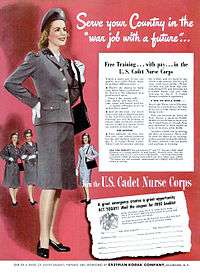
The Eastman Kodak Company sponsored a full-page advertisement in Life magazine (24 January 1944) touting the CNC as a way to serve the country in "a war job with a future". The advertisement said young women who could qualify as cadet nurses were "lucky girls" who were eligible for free training with pay, room and board, and gray uniforms with gray berets. The uniforms were described as one for summer and one for winter, which "you'll wear with pride". Applicants were assured they could wear something "frilly and feminine" instead of uniforms for dances, that they would have time for dating, and that many schools allowed students to marry.[33]
In the same year, a motion-picture company produced a recruiting film about the CNC called Reward Unlimited for the USPHS. Mary C. McCall Jr., wrote the story and Dorothy McGuire played the lead role of Peggy Adams, a cadet nurse.[32] The ten-minute film shows the way that Peggy Adams decided to become a cadet nurse, along with her training and everyday nursing experiences. Reward Unlimited was awarded the best recruitment film for 1944; it was shown in 16,000 theaters and seen by an audience of 90 million.[34] It was also likely many young women saw a newsreel clip of the CNC program at movie theaters; one such clip showed President Roosevelt signing the CNC bill into law and another featured the cadet uniforms.[35]
The American Hospital Association established recruitment centers in all 1,125 participating nursing schools. Using recruiting booths, volunteers disseminated information about the opportunities offered by the CNC to potential candidates. State and local nursing councils, and many other organizations, associations, and volunteers aided the recruitment effort.[36] In the fiscal year 1943—the first year of enrollment—65,521 nursing students registered. In the 1944 enrollment period, 61,471 registered. In the 1945 enrollment period, 3,000 students were admitted to what would be the final class of the program.[37] By 1945, because of the non-discrimination provision, over 3,000 African Americans,[31] 40 Native Americans,[38] and 400 Japanese Americans had enrolled in the CNC.[39]
Uniforms
.jpg)
The outdoor uniforms of the CNC were designed to be distinctive and to identify each cadet as a member of the corps. There was one uniform for winter and another for summer. The winter uniform was a gray, woolen, single-breasted jacket suit, a gored skirt, and a gray, velour overcoat. A gray Montgomery beret, similar to the one worn by the British general Montgomery, was worn with both of the uniforms. The summer uniform consisted of a two-piece, gray-and-white-striped, cotton suit and a gray twill raincoat.[40] The winter uniform was one of three designs created by professional designers and introduced at a fashion show in New York City on 16 August 1943. Thirty-two fashion editors judged this uniform and the Montgomery beret as the winners.[41] The selected uniform style was said to be attractive enough to have provided an incentive for young women to join the CNC.[42]
The official outdoor uniforms—with the exception of blouse, gloves, shoes, and stockings—were supplied to the cadets by the institution in which they were enrolled. The students paid for the excluded items.[43] The indoor or work uniforms varied from school to school; these were purchased by the school from federal grants.[32] Work uniforms were worn by the cadets while on duty in hospitals; the CNC patch on the sleeve of the uniform identified the wearer as a cadet.[44]
The insignia of the CNC was a Maltese Cross. A patch with the insignia was worn on the left shoulder of the uniforms and on the student nurse uniform of the official school of nursing.[42] The USPHS official insignia was worn on the jacket lapels and was also present on the silver buttons. On the Montgomery beret, the USPHS insignia was worn beneath the spread eagle and the American Shield.[40] Wearing the CNC outdoor uniforms was optional for all cadets, except when instructed to do otherwise.[43]
Training
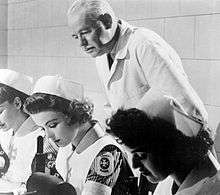
The participating schools of nursing were required to compress the traditional nursing program of 36 months to 30 months and to provide students with the four clinical experiences of medicine, surgery, pediatrics, and obstetrics. The students became senior cadets in the last six months before graduation, requiring them to serve in a federal or civilian hospital, where they provided the full-time service equivalent to that of a graduate nurse. During their first nine months of training, cadets were protected by regulation from working on the hospital wards for more than 24 hours each week. Junior cadets typically worked between 40 and 48 hours each week, including classes; senior cadets were free of classes. All state boards of nursing modified their regulations to agree with the accelerated program.[45]
The quality and standards of the educational systems in which cadets would be trained varied considerably. In 1943, nursing schools, hospital administrators, and government officials assured the U.S. Congress the federally subsidized training of nurses would conform to the minimum standards.[46] With his rule-making powers, the surgeon general issued these regulations:
- The school had to be accredited by the appropriate accrediting agency for schools of nursing in the state or territory;
- An institution offering a degree in nursing had to be accredited by the appropriate accrediting agency for universities and colleges.
- The school had to be connected with a hospital that had been approved by the American College of Surgeons, or that maintained standards of nursing equivalent to those required by the college. In a central school of nursing, the major hospital clinical unit had to meet these standards.
- The school had to require for admission not less than graduation from an accredited high school;
- The school had to maintain an educational staff adequate to provide satisfactory instruction and supervision;
- Its curriculum had to include all those units of instruction necessary to conform with accepted practices in basic nursing education.
- The school had to provide adequate clinical experience in the four basic services – medicine, surgery, pediatrics, and obstetrics;
- The school had to provide well-balanced weekly schedules of organized instruction, experience and study;
- The school had to provide adequate and well-equipped class rooms, laboratories, libraries, and other necessary facilities for carrying out the program, and satisfactory living facilities and health service for students.
- In evaluating the adequacy of the school facilities to meet the various requirements specified, the standards of the National League of Nursing Education were to be used as a guide.[47]
Congressional hearings on appropriations stressed all schools should be allowed to take part in the program.[48] When the standards were applied against the existing conditions, they did not seem practical for some schools to achieve. Some accommodations were made for smaller schools by lowering the standards for them. They would be judged by criteria that included the qualifications and number of instructional personnel, their clinical facilities, the curricula, the weekly schedule of hours, and the health and guidance programs. Such schools produced a small percentage of the cadet force.[49] While monitoring the standards of the 1,125 approved schools of nursing, the consultants of the Division of Nurse Education traveled thousands of miles, wrote countless letters, and provided direct and specific support services. The consultants were assigned to an area and each school was well-known to them.[50]
The CNC program operated from 1 July 1943 to 31 December 1948[51] and included three enrollment periods; the first term was in 1943, the second in 1944, and the third and final term was in 1945. During this time, 179,294 students enrolled in the program[52] and 124,065 of them graduated from the participating nursing schools[53] and became registered nurses.[54] The main cause of the withdrawals was homesickness; some married students withdrew to be with their husbands when they were released from the military; others when the hostilities ceased; some failed in their studies; others left for health reasons; and some left because of the stress of a nursing career.[24]
The CNC was the largest of the federal nurse training programs.[55] The federal government spent $160,326,237 on the Nurse Training Act of 1943 for administration, uniforms, maintenance, tuition, fees, and stipends. By the end of the program, the records of all participating schools of nursing had been audited. The work of the field auditors resulted in the recovery of $2,200,000 of prepaid funds.[56]
Cadet nurses
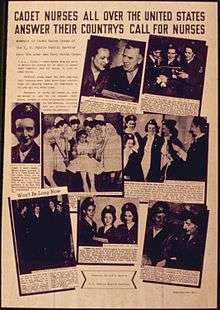
Cadet nurses came from every state in the U.S.; they were the daughters of farmers and mechanics, of teachers, lawyers, clerks and businessmen. Some joined because they wished to become nurses and others for the free education. In the course of their training, cadet nurses served in Army and Navy hospitals, with the Indian Health Service, with the Veterans' Administration, and in Public Health hospitals.[57] By the time World War II ended, student nurses were providing 80 per cent of the country's nursing care in more than 1,000 civilian hospitals.[58]
The American Hospital Association credited cadet student nurses with helping to prevent the collapse of civilian nursing care and commended them for replacing graduate nurses who enlisted in the armed forces during World War II.[57] In Cadet Nurse Stories, the authors noted the CNC program influenced the way in which future nurses would be educated and trained in the United States.[55]
Cadet stories
Florence Blake Ford of Philadelphia, gave the following reasons for becoming a cadet nurse:
Frankly I jumped at the opportunity to become a cadet nurse because it was free, and if I completed the course I could earn more money than I currently made as a clerk. This decision of convenience turned out to be a decision made in heaven. I loved nursing.[59]
Dorothie Melvin Crowley said about her experience:
My cadet experience challenged me intellectually and physically. I learned about myself and what I was capable of doing. I look back on those years with great nostalgia and with pride that I made it. History and circumstances came together in the right way, at the right time, to offer me the right life choices.[60]
Cadet hymn
The cadet hymn was composed by the director of music at Mt. Vernon Methodist Church in Washington, D.C. and the words were written by a member of the Division of Nursing Education of the USPHS. It was released in 1945 on the second anniversary of the CNC.[61]
Faithful ever to my country, to the Corps, my sacred trust,
Grant that I may follow wisely, all the guidance offered me.
Give me kindness, grant me patience,
That I may not fail this noble challenge to heal the suffering ones.
Help me to ally the sorrowing in a world torn by strife,
May I hold the lamp of nursing in the sprit of the Corps,
Give me strength, and grant me knowledge,
To pursue my chosen way with courage to heal the suffering ones.
Now I dedicate my service, pledge myself and all I am,
Thus to make of life a triumph, over sorrow over death,
Give me pride in my endeavor
In the service of my Corps, o grant that I may heal the suffering ones.[62]
References
Footnotes
- The Federal aid that followed was for nurse training and did not include aid for housing or classrooms.[5] After the passage of the Nurse Training Act of 1943, some Federal aid became available through another government source, which provided aid for housing and classrooms.[6]
- In G. I. Nightingales, Barbara Tomblin describes how the CNC became a new program: "The decision to create a new program rather than to reinstitute the old Army School of Nursing was a sharp break with Army Nurse Corps tradition. However, the Congress and the Army felt it would be more efficient and economical to use existing civilian nursing schools and facilities than to create a military structure to provide more graduate nurses ... ".[13]
- Advisory committee:
- Isabel M. Stewart, Columbia University
- Anna D. Wolf, Johns Hopkins Hospital
- Marion C. Howell, Western Reserve University
- Estelle Massey Riddle, National Nursing Council
- Margaret Tracy, University of California
- Sister Helen Jarrell, Loyola University
- James A. Hamilton, American Hospital Assn.
- Oliver C. Carmichael, Vanderbilt University
- Hyrum Leo Marshall, University of Utah
- A. M. Schwitalla, S.J., St. Louis University[17]
- The CNC pledge:
- "I am solemnly aware of the obligations I assume toward my country and toward my chosen profession, I will follow faithfully the teachings of my instructors and the guidance of the physicians with whom I work. I will hold in trust the finest traditions of nursing and the spirit of the Corps. I will keep my body strong, my mind alert, and my heart steadfast. I will be kind, tolerant, and understanding, Above all, I will dedicate myself now and forever to the triumph of life over death. As a Cadet nurse, I pledge to my country my service in essential nursing for the duration of the war."[23] The CNC pledge was considered a statement of intent rather than a binding contract[24]
Citations
- Robinson p. 27
- U.S. Public Health Service p. 2
- U.S. Public Health Service p. 3
- Robinson p. 29
- U.S. Public Health Service p. 10
- U.S. Public Health Service pp. 52-53
- Robinson p. 30
- U.S. Public Health Service p. 8
- Robinson p. 34
- U.S. Public Health Service p. 12
- Robinson p. 35
- Perry and Robinson p. 5
- Tomblin p. 190
- Robinson p. 41
- Szecsy p. 10
- Perry and Robinson p. 7
- U.S. Public Health Service pp. 20-21
- U.S. Public Health Service pp. 20-21
- U.S. Public Health Service p. 21
- U.S. Public Health Service pp. 23-24
- U.S. Public Health Service p. 23
- U.S. Public Health Service pp. 23–24
- Szecsy p. 47
- U.S. Public Health Service p. 38
- Szecsy p.12
- Bobinson pp. 41–42
- Perry and Robinson p. 6
- U.S. Public Health Service p. 52
- U.S. Public Health Service p. 53
- U.S. Public Health Service p. 26
- U.S. Public Health Service p. 31
- U.S. Public Health Service p. 30
- "Serve your Country in the "war job with a future" ... (advertisement)". Life. 24 January 1944. Archived from the original on 22 July 2016. Retrieved 11 November 2011.
- Robinson pp. 64-65
- Szecsy p. 21
- U.S. Public Health Service pp. 27–28
- Robinson p. 68
- Robinson p. 95
- Robinson p. 94
- Robinson p. 54
- Robinson p. 53
- Robinson p. 55
- Robinson p. 56
- Szecsy p. 29
- U.S. Public Health Service pp. 40–41
- U.S. Public Health Service p. 46
- U.S. Public Health Service pp. 46-47
- U.S. Public Health Service p. 47
- U.S, Public Health Service p. 48
- U.S. Public Health Service p. 51
- Szecsy p. 16
- Roinson p. 68
- Robinson p. 227
- Szecsy p. 20
- Perry and Robinson p. 196
- U.S. Public Health Service p. 60
- U.S. Public Health Service p. 34
- Robinson p. 112
- Perry and Robinson p. 30
- Perry and Robinson p. 125
- Perry and Robinson p. 63
- Szecsy p. 43
Bibliography
- Perry, Paulie M.; Robinson, Thelma M. (2001). Cadet Nurse Stories, The call for and response of women during World War II. Indianapolis, IN: Center Nursing Publishing. ISBN 1-930538-03-0.
- Robinson, Thelma M, (2009). Your Country Needs You, Cadet Nurses of World War II. Bloomington, IN: Xilbris. ISBN 978-1-4415-5378-2.CS1 maint: extra punctuation (link) CS1 maint: multiple names: authors list (link)
- Szecsy, Elsie, M. (2017). The U.S. Cadet Nurse Corps Guidebook: A History of a Program and Legacy of its People. USA: Kindle Direct Publishing. ISBN 9 781973 443759.
- Tomblin, Barbara, Brooks (1996). G.I. Nightingales, The Army Nurse Corps in World War II. Lexington, KY: The University Press of Kentucky. ISBN 0-8131-9071-1.
- U.S. Public Health Service (1950). PUB. NO. 38 (ed.). United States Cadet Nurse Corps [1943–1948] and other Federal nursing programs.

Further reading
- Robinson, Thelma M. (2005). Nisei Cadet Nurse of World War II: Patriotism in Spite of Prejudice. Black Swan Mill Press. ISBN 0615130224.